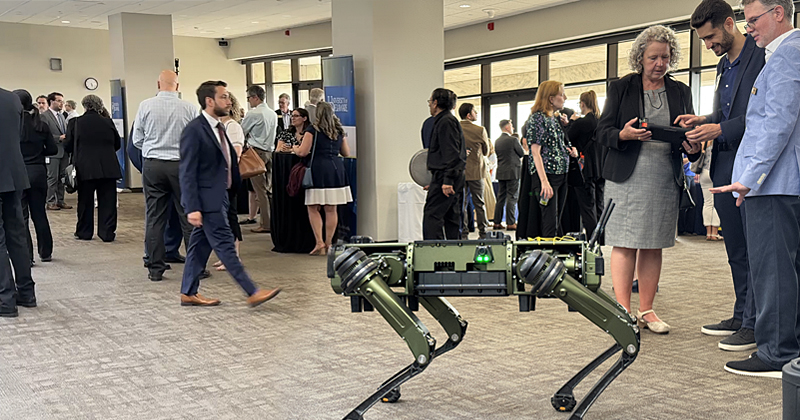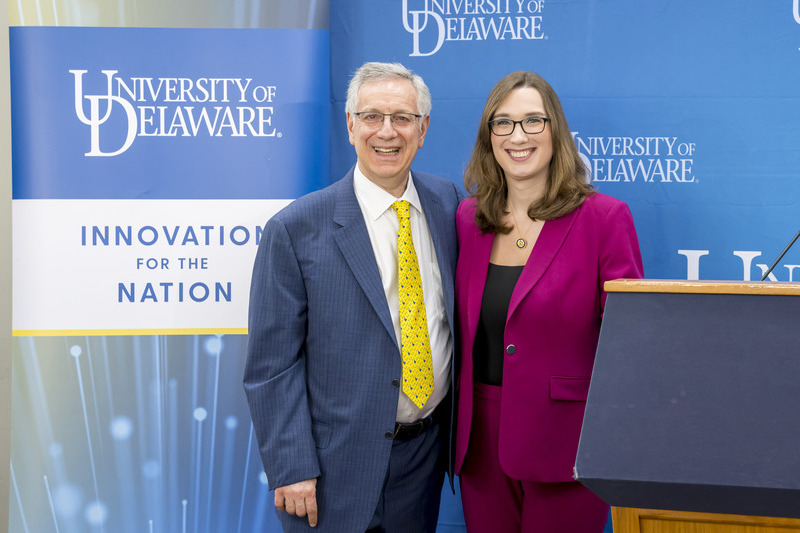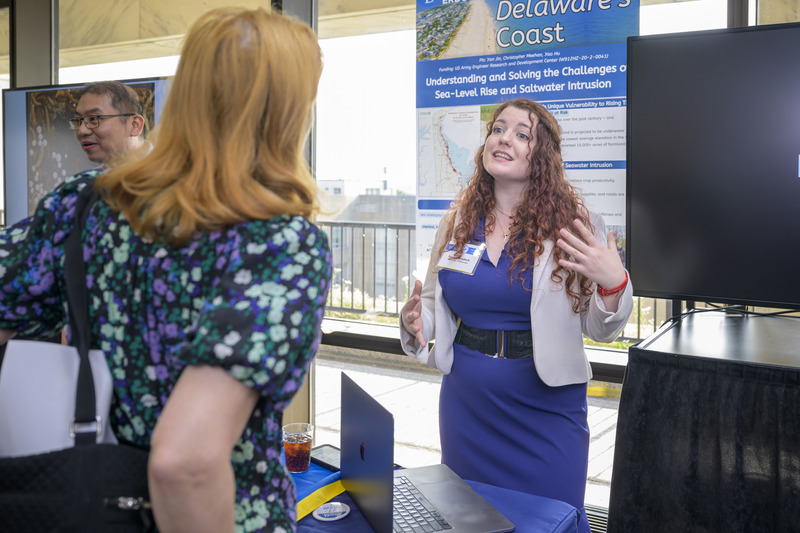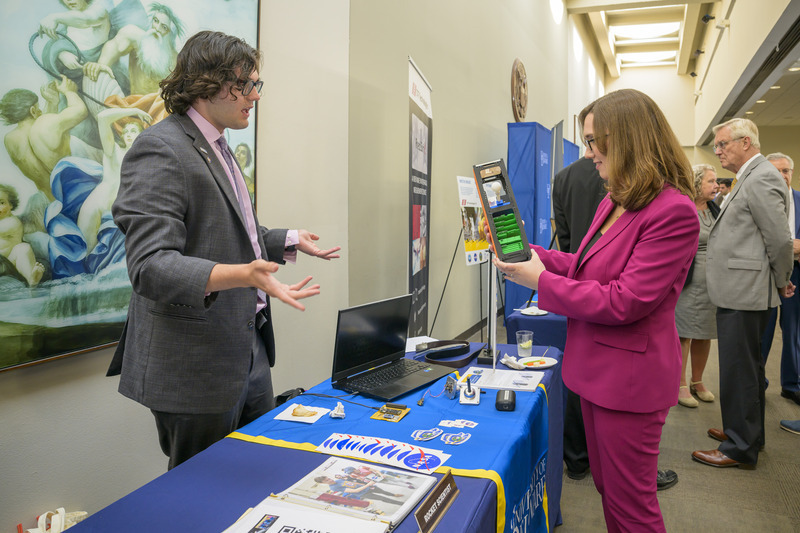


UD Day in D.C. celebrates the power of research
Photos by David Barczak and Kathy F. Atkinson June 13, 2025
‘Innovation for the Nation’ shows value of federally funded projects
Sometimes a text message, an email or a quick phone call will do. But there are definitely times when it’s important to be on location to meet in 3D.
That’s why University of Delaware leaders have made “UD Day in D.C.” a priority. Every other year, several dozen UD researchers and students make the trip to the nation’s capital to explain the impact of federally funded research and highlight its role in driving innovation, economic growth and scientific discovery.
It’s an especially important endeavor now, as federal funding for research faces unprecedented uncertainty, making it critical to reinforce the bipartisan commitment to scientific progress and innovation. On Thursday, June 12, U.S. Sen. Chris Coons hosted the seventh UD Day in D.C. in the Hart Senate Office Building. The theme was “Innovation for the Nation.”
Faculty members and students filled the room with exhibits and models, demonstrating and explaining the ways federally funded support has made important advances possible in a wide range of disciplines. They met with members of Congress, congressional committee staff members, UD alumni and other invited guests.
“This is an incredible event, where we see the innovation of the University of Delaware on full display,” said U.S. Rep. Sarah McBride, who serves on the Science, Space and Technology Committee in the House. “UD is not simply an educational institution; it’s a hub for economic activity and for innovation across sectors of society. You see how UD is leading the way in space exploration, in defense, in agriculture and health care. It’s really exciting to witness just a glimpse of the lifesaving and world-enhancing research happening around UD. Delaware is lucky to have this legacy institution as a central hub of education, research and economic activity.”
UD President Dennis Assanis thanked Delaware’s congressional delegation for its long history of support for UD, including the state’s senior Sen. Coons, the recently retired Sen. Tom Carper and newly elected Sen. Lisa Blunt-Rochester and Rep. McBride.
“Research transcends political divisions,” Assanis said. “After World War II, the United States developed an incredibly successful model for university research, which developed into a dynamic partnership among academia, government and the private sector. This collaboration propelled the U.S. into an era of scientific and technological success that has been unparalleled in human history. This has brought prosperity to the nation and has transformed the lives of Americans for generations. It has also made the United States a destination for the brightest minds from around the world.”
Research has improved the quality of life of Americans, strengthened national security, enhanced the United States’ global influence and served as a catalyst for economic growth and job creation, Assanis said.

Many examples were on offer Thursday, and there was plenty of “wow” factor in the room.
Martin Mitchell, who graduated from UD with a degree in psychology in 1991, likened the event to an “adult science fair.”
“I have always had a love for learning new science, whether it’s through Nova or PBS shows,” said Mitchell, who lives in Springfield, Virginia. “This is like an adult science fair, where you can learn from the experts about areas they’re so passionate about. The two that intrigued me most are the work with space suits and polymers and also the traumatic brain injury and MRI research. You can see the real-world impact to help people in challenging environments.”
After graduating from UD, Mitchell went to Georgetown University Law School, then served with the U.S. Air Force. He now teaches negotiations as an adjunct professor at Washington College of Law.
“Sharing the science is almost more important than doing the science,” said Ross Klauer, a doctoral student who works with mentors Mark Blenner and Kevin Solomon, professors in UD’s Department of Chemical and Biomolecular Engineering. He is studying how microbes that were found feeding on plastics in the guts of mealworms could be useful in addressing other environmental crises.
All of this is worth protecting and supporting, McBride said.
“It’s incumbent upon all of us in public office to continue to support the robust research ecosystem that we have developed between public and private institutions across this country,” she said. “That ecosystem, that leadership and that research is facing a crisis of chaos, uncertainty and in many cases outright attacks.
“I’m thrilled to know that we have leaders at the University of Delaware who continue to protect the institution, fight for the institution and move the institution forward in pursuit of both shared values and common goals. It’s important for those of us in leadership right now to make it clear that developing a diverse talent pipeline, that fostering the talents of scientists of engineers of researchers of academics of all backgrounds is not just symbolically good, it’s our country’s competitive advantage.”
John Anderson, a UD alum who now serves as president of the National Academy of Engineering, applauded McBride’s comments.
“The congresswoman was spot on in her remarks,” he said.
Anderson also enjoyed reconnecting with UD Prof. Norman Wagner, a fellow of the National Academy of Engineering and the Unidel Robert L. Pigford Chair in Chemical Engineering. Wagner earned his doctorate at Carnegie Mellon when Anderson chaired the department there. Wagner’s firm STF Technologies is of interest to NASA for its shear-thickening fluid, which can be used to strengthen spacesuits and protect astronauts.
“Science discovers, engineers create,” Anderson said. “You need both. Across the country, we’ve got to support young people going on for graduate degrees. The workforce is the most important asset you have. If you stop funding this stuff, it’s not just the research you’ll lose — you’ll lose future innovators.”
Innovation was on full display throughout the room.
In one section, a large-but-well-controlled robot in the shape and form of a dog drew lots of attention. The robot has enough canine mannerisms that you almost want to offer it a treat or maybe a bowl of water.
Bert Tanner, professor of mechanical engineering and director of UD’s Center for Autonomous and Robotic Systems, and doctoral student Athanasios Augeris, talked to many people about this beast and the sensors they are developing to expand its potential work and the function of other robotic devices.
Among their goals is to enhance the ability of robots to work autonomously, help them navigate different kinds of terrain and get out of difficult situations. They also are working to improve perception, so the robot understands what it is seeing. And they are working with other scientists, such as oceanographers, to improve robotic applications in studies such as beach mapping.
Beach mapping is done before a storm rolls in, to study the effects of the storm in various tidal areas. That means measurements must be taken before the storm arrives, which presents a significant time challenge.
“It’s a race against the clock,” Tanner said. “If a storm is coming, there is only so much time.”
Robots can help to make those measurements with greater speed.
The field of robotics also has important applications in security inspections, such as those needed at contaminated industrial sites, and for emergency response after earthquakes or hurricanes, where they might have to move over rubble and other uneven, dangerous territory.
“Robots can be a force multiplier,” Tanner said.

Jonathan Skovholt, who earned his master’s degree in physics at UD in 2005, is now the head of search operations for Ensemble IP, a professional patent search firm. He has also worked for the U.S. Patent and Trademark Office in Washington, D.C.
Thursday’s reception was the first alumni event Skovholt had attended. He was interested to see what UD was doing in innovation and technology.
To do his work investigating patents, he has to know the basic technologies involved.
“The technologies are blending now,” he said. “You have electrical engineers working in biotechnology, for example. It’s very interesting to see that, in general. And UD is on the forefront of it.
“I’m sure some of this work will be incubated and they could possibly come up with the next unicorn,” he said with a smile.
Skovholt was especially impressed with two plastics-related projects — the effort by Prof. LaShanda Korley’s Center for Plastics Innovation to break down plastics and develop new plastics that are easier to reuse and recycle and the effort Klauer is making to find new ways of using the byproducts left by plastic-eating microbes.
“I would expect to see some of this in the marketplace in the next five years, certainly in the next 10,” Skovholt said. “I’ve seen some that could really go far if they can figure out the plastics thing.”
Erik Thostenson, professor of mechanical engineering and materials science, was on hand to explain new wearable sensors his lab is developing with Jill Higginson, the George W. Laird Professor of Mechanical Engineering and director of UD’s Institute for Engineering-Driven Health.
Thostenson said he read an article in The Philadelphia Inquirer about a sensor Higginson was using in a smart boot her team had developed to help people who use prosthetics. She told the reporter she wasn’t happy with the performance of the button sensor in the device. When Thostenson read that, he was pretty sure he had a better sensor to offer — one his team was developing. He got in touch with her and a new collaborative endeavor was launched.
“We had a sensor just waiting for an application,” Thostenson said.
Jocelyn Alcántara-García, associate professor of art conservation and chemistry and biochemistry, and her students have been studying all kinds of materials, recently focusing on the chemistry of wooden objects. This is of importance for investigating imported woods as well as to museums and other institutions. She uses lasers and X-rays and chemical analysis in the work.
This fascinated Valerie Emerson, who graduated from UD in 1979 with a degree in international relations. Emerson, who lives in Arlington, Virginia, worked for a while in the library of George Washington University, helping graduate students finish their dissertations. She loved talking with them about their work and that was one reason she wanted to attend UD Day in D.C.
She was amazed by Klauer’s discussion of how microbes in mealworms might one day help to solve a range of environmental problems.
“That blew my mind,” Emerson said. “It’s a simple thing, but it could have huge implications.”
Robin Reath of Washington, D.C. majored in English at UD and graduated in 1984. After graduation, she worked in many settings — in restaurants, in the hotel industry, as an administrator at Georgetown Hospital.
Her husband is a scientist at the National Institute of Standards and Technology and she enjoyed seeing the many avenues UD research has taken, including NASA research, studies of sea-level rise and different ways to address plastics pollution.
“The University of Delaware meant a lot to me,” she said, “and it is still very special to me.”
The day was an “incredible experience” in the opinion of T.J. Tomaszewski, a senior honors physics major who hopes to pursue his doctorate at UD. Tomaszewski accompanied his research mentor, Bennett Maruca, associate professor of physics and astronomy and director of the Delaware Space Observatory Center, with whom he has been studying plasma physics and working to develop Delaware’s first orbital spacecraft.
“I’ve been able to speak with a lot of different people about our project and represent our programs in space physics, heliophysics and the Delaware Space Grant,” he said.

Contact Us
Have a UDaily story idea?
Contact us at ocm@udel.edu
Members of the press
Contact us at 302-831-NEWS or visit the Media Relations website

